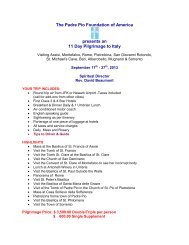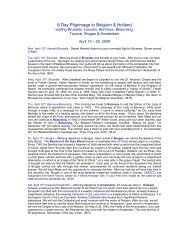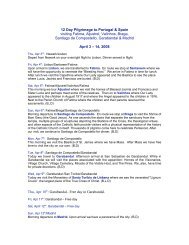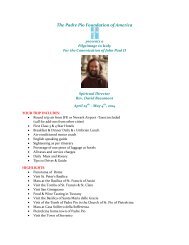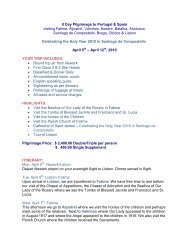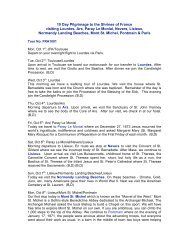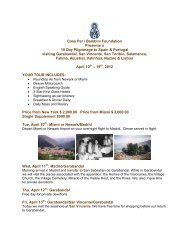The Padre Pio Foundation of America presents a 14 Day Pilgrimage ...
The Padre Pio Foundation of America presents a 14 Day Pilgrimage ...
The Padre Pio Foundation of America presents a 14 Day Pilgrimage ...
Create successful ePaper yourself
Turn your PDF publications into a flip-book with our unique Google optimized e-Paper software.
<strong>The</strong> largely intact city wall, some <strong>of</strong> which was built 700 years ago, is one <strong>of</strong> the finest examples<br />
<strong>of</strong> its kind in the world. <strong>The</strong> importance <strong>of</strong> religion in the city's past and present culture is reflected<br />
in a number <strong>of</strong> impressive Franciscan and Dominican convents and churches. <strong>The</strong> relics <strong>of</strong> St.<br />
Blaise can be found in the Cathedral which is just beyond the city wall.<br />
Sun, Apr 26 th : Venice/Padua<br />
Arrival in Venice 9:00 AM Optional excursions will be <strong>of</strong>fered<br />
Upon arrival in Venice you will be met by your guide. If you have taken an Optional Excursion in<br />
Venice, your luggage will be collected and you will go on your tour. After your tour, you will meet<br />
the rest <strong>of</strong> your group and be transferred to your hotel in Padua. This afternoon you will visit the<br />
Basilica <strong>of</strong> St. Anthony <strong>of</strong> Padua. (B,D)<br />
Venice is considered the city <strong>of</strong> art, romance and prestige. <strong>The</strong> extraordinary architecture was<br />
built on an archipelago <strong>of</strong> small islands separated by a network <strong>of</strong> canals crossed by<br />
approximately 400 bridges, once wooden and then replaced by stone.<br />
<strong>The</strong> Grand Canal is the main city artery. It is crossed by three bridges and has the shape <strong>of</strong> an<br />
upside down "S" dividing the city in two parts and in their turn divided into six "sestieri" (districts):<br />
Cannaregio, San Marco and Castello on the left side; Santa Croce, San Polo and Dorsoduro on<br />
the right side <strong>of</strong> the canal. Water transport undoubtedly prevails over land travel, with gondolas,<br />
ships, ferries, and yachts serving as taxis to transport people and goods. <strong>The</strong>re are few main<br />
roads and several small "calli" (narrow streets) developed along canals, "campi" (squares<br />
adjacent to churches), bell towers and "fondamenta" (streets along the canals) where motor<br />
vehicles are not allowed. Refugees from Spina Adria and Aquileia after the invasion <strong>of</strong> the Huns<br />
in the 5th century AD founded Venice.<br />
<strong>The</strong> Doge under the protection <strong>of</strong> the Byzantine Empire governed it by "maritime tribunes" and<br />
later, in the 9th century the city became a very important commercial port, connecting the eastern<br />
and western markets through the Adriatic Sea. Its commercial power soon resulted in military<br />
power. Within a few years, Venice dominated all the eastern Adriatic coast, reaching the East,<br />
colonizing the territories and conquering important markets, competing with Genoa and with the<br />
other Maritime Republics to assert its power.<br />
<strong>The</strong> Turks chased the Venetians from many eastern colonies. <strong>The</strong> repercussions <strong>of</strong> the French<br />
Revolution affected this perfect aristocratic government where commerce and military power<br />
supported each other. In 1797 Venice was weak and after the Camp<strong>of</strong>ormio treaty, it was subject<br />
to Austria and subsequently annexed by Italy. <strong>The</strong> Grand Canal, <strong>of</strong>fers a quick view <strong>of</strong> the most<br />
beautiful palaces in Venice: the Academia, the Cà d'Oro, the Casino, the palace <strong>of</strong> the Biennial,<br />
the University, the Chiesa della Salute and the popular Rialto bridge, up to Piazza San Marco<br />
where the canal opens into a wide area.<br />
<strong>The</strong> square is the heart <strong>of</strong> Venice and its symbol. It is an architectural jewel and one <strong>of</strong> the most<br />
beautiful squares in Italy; a miracle built in trachyte and Istrian stone. In the past, religious and<br />
civil ceremonies took place in this square and also the famous Carnival. At its end there is the<br />
Basilica and the Clock Tower. <strong>The</strong> c<strong>of</strong>fee bars and restaurants surrounding it are pleasant<br />
meeting places. Glass blowing is particularly interesting and takes place on the Island <strong>of</strong> Murano.<br />
Mon, Apr 27 th : Padua/Assisi - Morning departure to Assisi. Upon arrival, we visit the Basilicas <strong>of</strong><br />
St. Francis and St. Clare, where we see the Tombs <strong>of</strong> the two Saints. Next we visit the Basilica<br />
<strong>of</strong> Santa Maria degli Angeli where we see the Porziuncola (the little church St. Francis built).<br />
(B,D)<br />
Tue, Apr 28 th : Assisi/San Giovanni Rotondo – Morning departure to San Giovanni Rotondo.<br />
Today we travel south, and along the Adriatic Coast, passing through the regions <strong>of</strong> Marche,<br />
Abruzzo and Apulia to San Giovanni Rotondo to visit the Basilica <strong>of</strong> Our Lady <strong>of</strong> Grace. During



